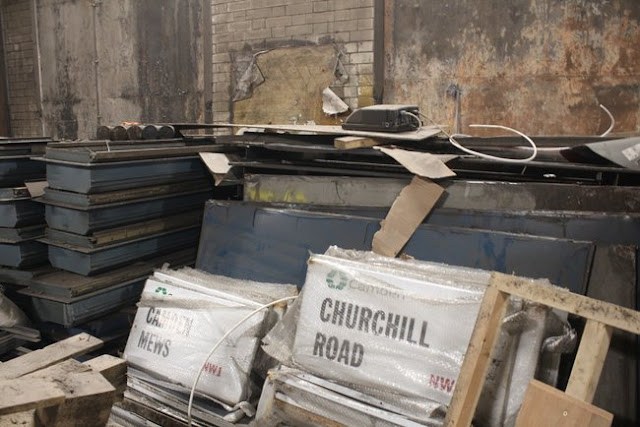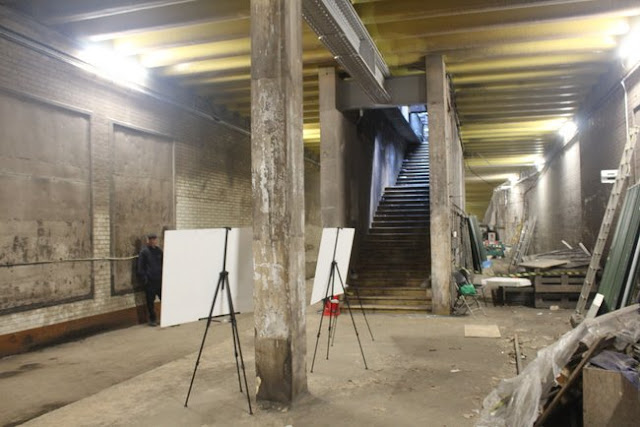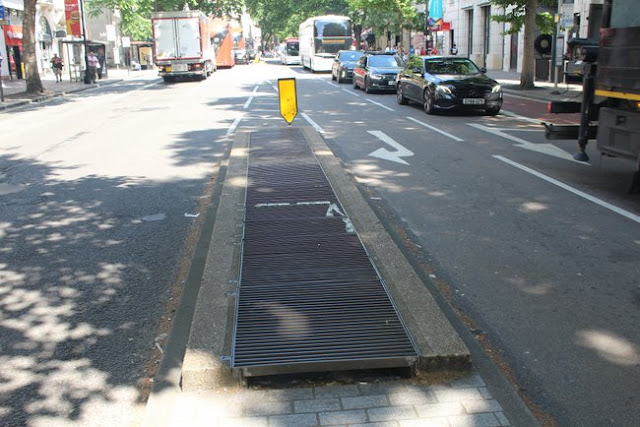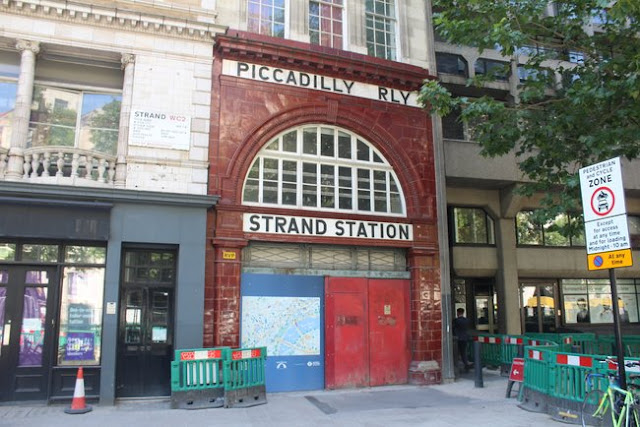A guided walk in the former tramway subway and short walk above ground in Holborn and Aldwych
Google Map
1936 Map
In the late 1800s large areas of Holborn in London were regenerated with slum houses cleared and wide boulevards built. The opportunity was taken to link up tram networks in the south and north of London. The Kingsway Tramway Subway was based on examples built in America. It offered the advantage of giving the trams a clear route through the city traffic but was largely built to keep the trams used by the lower classes out of view in the gentrified Holborn district.
The subway ran from the intersection of Bloomsbury Way and Southampton Row to Waterloo Bridge. Originally it was intended to cross river here but in the end the tramway crossed Westminster Bridge, despite many politicians not wanting the rif raf passing parliament on their trams.
The Subway had two intermediate stops. Holborn close to the north end of the subway and outside Holborn tube station and Aldwych. It opened in 1906, though for the first two years trams from the north terminated at Aldwych. Initially the tramway could only be used by single decker trams but after closure for nearly a year in 1930 it was dug deeper to allow double decker trams to use the subway. In 1937 the south entrance was also repositioned to the centre of the widened Waterloo Bridge instead of trams emerging on the west side of the bridge as they had previously done.
After the second world war London decided to close its tram network. The subway fell in to disuse in 1952 when the tram system was abandoned. In 1958 it was proposed to convert part of the subway to a one way road underpass to ease congestion at the junction of Waterloo Bridge and the Strand. Reconstruction began in 1962 and the Strand Underpass opened in 1964.
The north section of subway remained abandoned and was simply used by Camden Council to store street furniture. In recent years guided tours operated by the London Transport Museum have operated in the abandoned section of subway. I joined one of these tours and further explored the area above ground on foot.
More about the subway can be found on the Wikipedia article
More information about London Transport Museum's Hidden London tours
Below - The north entrance to the subway remains as it was when it closed, just with gates across the entrance at street level. Being on a guided tour I got to go through the gates rather than poking my camera through them as I had on a previous occasion. Note the slot between the two lines, in central London the trams drew their electricity from a contact in the grove rather than overhead wires, rather like the system used by Scalextric cars. A device known as a plough that ran in the grove was fitted beneath the tram, where the trams were switched from one system to the other "Ploughmen" disconnected the plough which would be run off on the rail to one side for use by a tram heading in to the central section.
Below - Looking back towards Bloomsbury Way from the subway entrance.
Below - The entrance to the subway.
Below - The subway entrance seen from the back above ground.
Below - In the subway the tramway descends steeply to pass beneath the Fleet Sewer and climbs to Holborn subway station. The gradient before the station would have helped prevent trams overrunning the station after the descent in to the tunnel.
Below - Looking towards Holborn station. This area was used in recent years as part of construction of the Elizabeth Line as one of several sites where grout was pumped in to the surrounding ground to keep it stable as the tunnel was constructed beneath. The subway was returned to its original condition afterwards with just a little evidence of more recent concrete underfoot.
Below - Approaching Holborn the subway widens to accommodate a platform between the two tracks. Two staircases were provided from street level. The back of one of the staircases can be seen.
Below - At ground level the staircases would have been surrounded by railings on three sides and signage. Now they are just covered in metal grilles. The grill over the staircase next to Holborn tube station can be seen. It is possible to see the staircase through the grille.

Below - The northern staircase seen from the platform level.
Below - Looking back to the subway widening as the tram tracks pass either side of the staircases and platform.
Below - Looking along the platform of the former Holborn tramway subway station. This was built with glazed bricks and a marble platform to give it a bright environment. The platform could accommodate these trams at once. The site of the track on the other side has been filled to platform level and has been buried under stored (or dumped?) street furniture.
Below - The glazed bricks and places for pasting up posters can be seen.
Below - Site of the northbound track now buried under street furniture. The Union Street underground sign is from filming that took place at the former station shortly after closure.
Below - The southern staircase of Holborn station.
Below - The southern staircase seen from street level.
Below - Behind the southern staircase are the remains of a fire bucket point. Nearby a large box covered with a tarpaulin contains an automatic fire suppression system for nearby cable tunnels.
Below - Looking back towards Holborn station a crossover can be seen in the tracks to allow trams to be turned back at Holborn in case of breakdowns or other eventualities. The fire suppression system can be seen on the left. Note the height of the refuges in the side walls, this was a result of the work to increase the height of the subway to take double deck trams by digging it out deeper.
Looking towards the end of the abandoned section. Beyond this it is partly filled to build a roadway ramp up to street level for the Strand Underpass.
Below - Above ground and facing the same direction a little further along, the Strand Underpass emerges from the former subway to street level. This is around the site of the Aldwych tram station but any trace of this was lost when it was rebuilt for road traffic.
Below - The roadway from Waterloo Bridge descends in to the former tramway subway next to Somerset House.
Below - The tramway used to emerge at road level beneath Waterloo Bridge. Though much of this last southern most stretch of subway was filled to build the roadway ramp from bridge height part of it is in use as a night club. Originally the south entrance was to the west of the bridge but was rebuilt with the rebuilding of the bridge.
Whilst in the area I decided to visit the above ground remains of the former Aldwych tube station. Aldwych, originally known as Strand station, got relegated to a branch line when proposals to extend the Picadilly line south under the river where abandoned in favour of a new line west diverging from the stop before at Holborn. With large parts of the station underground abandoned without even being completed it continued as the end of a short branch from Holborn until closure in 1994. The station has remained intact and occasionally used for filming. More information can be found about the station on the
Wikipedia article
Below - The Aldwych branch on the tube map shortly before closure. Shown dotted to denote the limited peak time shuttle service that had operated on the line since the 1962.
Above ground the station is L shaped with a main entrance on Surrey Street and a side entrance on the Strand.
Below - Sign in the main entrance to the former station.
Below - The former main entrance on Surrey Street.
Below - Former side entrance on the Strand.






























No comments:
Post a Comment